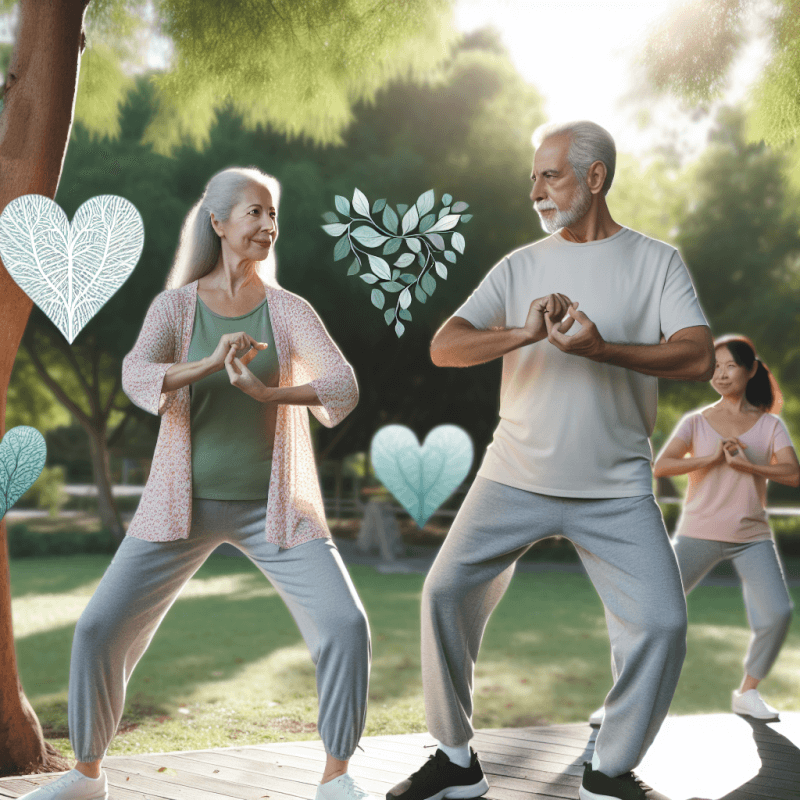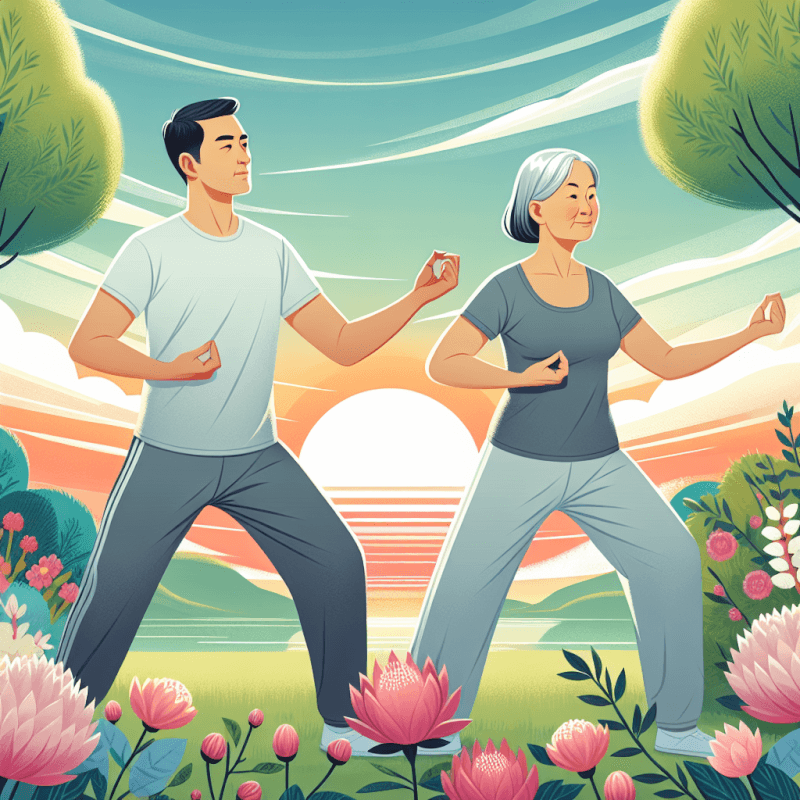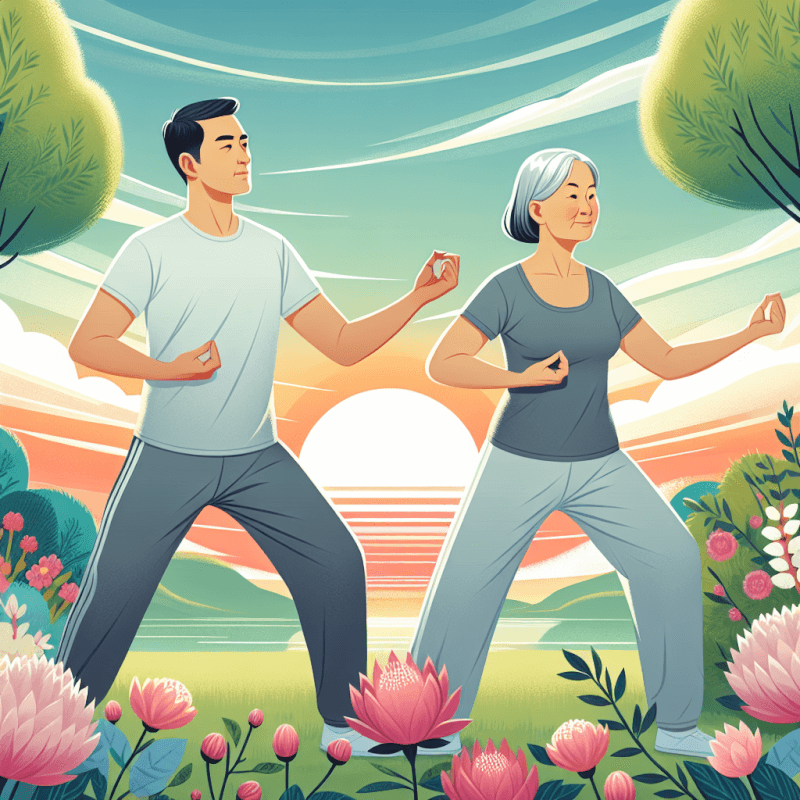As you age, it becomes increasingly important to prioritize your cardiovascular health. But with so many exercise options out there, it can be overwhelming to know which ones are truly beneficial for older adults. That’s why this article will provide you with a concise guide on the best cardiovascular exercises tailored specifically to meet the needs of older adults. Whether you’re a fitness enthusiast looking for new options or simply someone aiming to lead a healthier lifestyle, this article will provide you with valuable insights and recommendations to improve your cardiovascular fitness and overall well-being. As we age, staying active and maintaining a healthy lifestyle becomes increasingly important. Engaging in regular cardiovascular exercise is not only beneficial for your physical health, but also for your mental well-being. It can help improve cardiovascular health, strengthen muscles, enhance balance and coordination, boost energy levels, and even reduce the risk of chronic diseases. If you’re an older adult looking to incorporate cardiovascular exercise into your routine, here are some of the best options to consider:
Walking
Walking is a fantastic cardiovascular exercise that is low-impact and suitable for people of all fitness levels. It requires no special equipment, and can easily be incorporated into your daily routine. The benefits of walking for older adults are numerous. It helps improve cardiovascular fitness, aids in weight management, strengthens bones and muscles, and even reduces the risk of chronic conditions such as heart disease and diabetes. To incorporate walking into your routine, start with a short distance and gradually increase the duration and intensity as your fitness improves. Aim for at least 30 minutes of brisk walking most days of the week.
Tips for a safe and effective walking workout
When walking for exercise, it’s important to keep a few tips in mind to ensure a safe and effective workout. First and foremost, make sure you’re wearing comfortable, supportive footwear to protect your feet and prevent injuries. Warm up with a few stretches before starting your walk, and cool down with some gentle stretches afterward. Pay attention to your posture and engage your core muscles to maintain proper alignment. Start with a slow pace and gradually increase your speed. If you’re walking outdoors, choose safe, well-lit areas and wear reflective clothing if walking during low-light conditions. Finally, listen to your body and take breaks when needed – it’s better to go at your own pace and gradually build up your endurance.
Swimming
Swimming is an excellent cardiovascular exercise that is gentle on the joints, making it an ideal option for older adults. It provides a full-body workout, engaging both the upper and lower body muscles. Swimming not only improves cardiovascular health, but also helps build strength and flexibility. It is a low-impact exercise that reduces the risk of injuries, making it suitable for individuals with arthritis or joint pain. Additionally, being immersed in water provides resistance, which helps tone muscles and improve stamina. Swimming can also have a positive impact on mental well-being, reducing stress and promoting relaxation.
Water safety precautions for seniors
While swimming is a great exercise for older adults, it’s important to take some safety precautions. Before starting any swimming routine, consult with your healthcare provider, especially if you have any underlying health conditions. If you’re new to swimming or haven’t swum in a while, consider taking swimming lessons or seeking guidance from a certified swimming instructor. Make sure the swimming facility you choose has lifeguards on duty and follow any safety guidelines they provide. It’s also important to start slowly and gradually increase the duration and intensity of your swimming sessions. Finally, listen to your body, and if you experience any pain or discomfort, stop and seek medical advice.

Cycling
Cycling is another excellent cardiovascular exercise that offers numerous benefits for older adults. It is a low-impact activity that places minimal stress on the joints, making it a great option for individuals with arthritis or joint pain. Cycling helps improve cardiovascular fitness, strengthens leg muscles, and enhances balance and coordination. It can also be a fun and social activity, allowing you to explore new places and enjoy the outdoors. When it comes to choosing the right bicycle, opt for one that is comfortable and properly fitted to your body. Consider a hybrid or recumbent bike if you have concerns about balance or stability. Before starting a cycling routine, make sure to wear a helmet and other protective gear, and familiarize yourself with local traffic laws and safety guidelines.
Safety tips for cycling in older age
While cycling is generally a safe activity, it’s essential to take certain precautions, especially as an older adult. Start with shorter rides and gradually increase the duration and intensity as your fitness improves. Always warm up with some stretching exercises to loosen up your muscles before getting on the bike. Pay attention to your physical condition and avoid cycling in extreme weather conditions or when you’re feeling unwell. Stay hydrated by drinking plenty of water before, during, and after your rides. It’s also important to be aware of your surroundings, follow traffic rules, and make yourself visible to others by wearing bright, reflective clothing and using lights on your bike. Lastly, regularly inspect your bicycle to ensure it is in good working condition and consider having it serviced by a professional to maintain its safety.
Elliptical training
Elliptical training is a low-impact cardiovascular exercise that provides an effective full-body workout. It mimics the motion of walking or running but eliminates the impact on the joints, making it a suitable option for older adults with joint pain or arthritis. Elliptical training improves cardiovascular fitness, strengthens muscles, and enhances balance and coordination. It also allows you to control the intensity of your workout by adjusting the resistance level and incline. When using an elliptical machine, focus on maintaining proper form and technique. Stand tall with your core engaged, and push and pull the foot pedals in a smooth and controlled motion. Start with a comfortable resistance level and gradually increase it as you become more comfortable and stronger.
Precautions and considerations for seniors
If you’re new to elliptical training or have any underlying health conditions, it’s important to consult with your healthcare provider before incorporating this exercise into your routine. They can provide guidance on the intensity and duration that is suitable for your fitness level and any limitations you may have. When using an elliptical machine, start with shorter sessions to allow your body to adapt to the new movement and gradually increase the duration over time. Pay attention to your body and stop if you experience any pain or discomfort. It’s also important to warm up and cool down before and after your elliptical workout with some light stretching exercises. Finally, stay hydrated by drinking water before, during, and after your workout.

Dancing
Dancing is a fun and enjoyable cardiovascular exercise that offers numerous physical and mental benefits for older adults. It combines aerobic activity with rhythm and music, making it an engaging and social way to stay active. Dancing improves cardiovascular fitness, strengthens muscles, enhances flexibility and balance, and even helps maintain cognitive function. It can also boost mood and reduce stress, making it a great activity for overall well-being. There are many dance styles suitable for older adults, such as ballroom, salsa, line dancing, and even Zumba. Consider joining dance classes or groups in your local community or participating in virtual dance sessions.
How to find dance classes or groups
Finding dance classes or groups for older adults can be an exciting endeavor. Start by checking your local community centers, senior centers, or gyms to see if they offer dance classes specifically designed for older adults. You can also reach out to dance studios in your area and inquire about classes suitable for your age and fitness level. Many dance studios and community centers now offer virtual classes, which can be a great option if you prefer to dance from the comfort of your own home. Lastly, consider joining social or hobby groups that organize dance events or gatherings, as they can provide a fun and supportive environment to learn and practice dancing.
Aquatic exercise
Aquatic exercise is an ideal option for older adults as it provides the benefits of cardiovascular exercise while minimizing impact on the joints. Exercising in water helps reduce stress on the bones, joints, and muscles, making it suitable for individuals with conditions such as arthritis or joint pain. Water-based exercises also provide resistance, which helps strengthen muscles and improve overall fitness. Aquatic exercise improves cardiovascular health, enhances flexibility and range of motion, and promotes relaxation. It can include activities such as water aerobics, water walking, or swimming laps.
Water-based exercises and movements to try
When engaging in aquatic exercise, there are various activities and movements you can incorporate into your routine. Water aerobics classes are a popular option for older adults, as they typically include a variety of exercises that target the whole body. These classes often involve movements such as arm swings, leg kicks, marching or jogging in place, and even jumping jacks in shallow water. Water walking or jogging is another excellent option that allows you to work on your cardiovascular fitness while enjoying the buoyancy of the water. Consider trying different strokes while swimming laps to engage different muscle groups and add variety to your routine. You can also use water weights or resistance bands to further challenge your muscles and enhance strength training.
Water safety guidelines for seniors
While aquatic exercise is generally safe for older adults, it’s important to prioritize safety when in or around water. Before starting any aquatic exercise program, consult with your healthcare provider, especially if you have any underlying health conditions. If you’re new to swimming or engaging in water-based activities, consider taking swimming lessons or seeking guidance from a certified instructor to ensure proper form and technique. Always warm up before getting into the water and cool down afterward with some stretches. It’s also important to be aware of your surroundings and follow any safety guidelines provided by the facility. If swimming in open water, make sure to check for hazards and currents and swim in designated areas with lifeguards. Finally, stay hydrated by drinking water before, during, and after your aquatic exercise session.

Low-impact aerobics
Low-impact aerobics is a form of cardiovascular exercise that minimizes stress on the joints while providing an effective workout. It involves rhythmic movements and exercises that keep one foot on the ground at all times, reducing the impact and strain on the joints. Low-impact aerobics is suitable for older adults who may have arthritis, joint pain, or a limited range of motion. Engaging in low-impact aerobics benefits older adults in several ways. It improves cardiovascular fitness, strengthens muscles, enhances flexibility and balance, and even promotes bone health. Additionally, low-impact aerobics can be modified to suit different fitness levels, making it accessible to individuals of varying abilities.
Tips for a safe and effective low-impact aerobics session
To ensure a safe and effective low-impact aerobics session, it’s important to follow a few guidelines. Start by choosing the appropriate shoes that provide support and cushioning for your feet. Make sure you have enough space to move around comfortably and clear any potential obstacles in your workout area. Begin with a warm-up that includes gentle stretches and joint mobility exercises to prepare your body for the workout. When performing the exercises, focus on maintaining proper form and technique, and listen to your body. If an exercise causes pain or discomfort, modify or skip it altogether. Gradually increase the intensity and duration of your low-impact aerobics sessions as your fitness improves. Finally, cool down with some gentle stretching exercises to help your body recover.
Stationary biking
Stationary biking is a low-impact cardiovascular exercise that provides numerous benefits for older adults. It allows you to engage in cycling without the need to balance or navigate outdoor terrain. Stationary biking improves cardiovascular health, strengthens leg muscles, and enhances endurance. It also offers the flexibility to adjust the resistance level and intensity, making it suitable for individuals of all fitness levels. Setting up and adjusting a stationary bike to your preferences is crucial to ensure a comfortable and effective workout.
Setting up and adjusting a stationary bike
When setting up a stationary bike for your workout, there are a few key considerations. Start by adjusting the seat height so that when you’re pedaling, your legs are almost fully extended but with a slight bend in the knees. Ensure that your feet can comfortably reach the pedals without straining. The position of the handlebars should allow you to maintain an upright posture without leaning too far forward or backward. Make any necessary adjustments to the resistance level before starting your workout – start at a comfortable level and gradually increase it as you become more comfortable and stronger. It’s also essential to wear appropriate athletic shoes that provide stability and support during your stationary biking session.
Precautions and tips for a successful stationary biking routine
While stationary biking is generally a safe exercise, it’s important to consider a few precautions and tips to have a successful workout. If you have any underlying health conditions or concerns, consult with your healthcare provider before starting a stationary biking routine. Warm up before getting on the bike with some light stretching exercises to prepare your muscles. Start with shorter sessions and gradually increase the duration and intensity of your workouts as your fitness improves. Pay attention to your body and adjust the resistance level or pacing if you experience any pain or discomfort. Stay hydrated by having a water bottle nearby and taking sips during your workout. Lastly, cool down with some light stretches to help your muscles recover and prevent stiffness.

Rowing
Rowing is a full-body cardiovascular exercise that provides numerous benefits for older adults. It engages both the upper and lower body muscles, including the arms, shoulders, back, abdominals, and legs. Rowing improves cardiovascular fitness, builds strength and endurance, and enhances flexibility and posture. It is a low-impact exercise that puts minimal stress on the joints, making it suitable for older adults who may have arthritis or joint pain. Proper rowing technique and form are crucial to ensure an effective and safe workout.
Proper rowing technique and form
When it comes to rowing, proper technique and form are essential for a safe and efficient workout. Start by sitting on the rowing machine with your feet securely strapped in and your legs extended in front of you. Begin the movement by pushing off with your legs while maintaining a straight posture and engaging your core. As your legs reach full extension, lean back slightly and pull the handle towards your chest, keeping your elbows close to your body. Extend your arms forward while simultaneously bending your knees to return to the starting position. Focus on a smooth, controlled motion throughout the exercise and avoid jerking or using excessive force. It’s important to start with a low resistance level and gradually increase it as your technique and strength improve.
Important considerations and safety precautions
Before incorporating rowing into your exercise routine, it’s important to consider a few factors and take safety precautions. If you’re new to rowing or have any underlying health conditions, consult with your healthcare provider to ensure it is a suitable exercise for you. Familiarize yourself with the rowing machine and learn how to use it properly before starting your workouts. Proper form and technique are crucial to prevent injuries, so consider seeking guidance from a certified rowing instructor or watching instructional videos. Start with shorter sessions and gradually increase the duration and intensity as your fitness improves. Pay attention to your body and take regular breaks if needed. Finally, stay hydrated by drinking water before, during, and after your rowing sessions.
Tai Chi
Tai Chi is an ancient Chinese martial art that combines slow, flowing movements with deep breathing and mental focus. It is a gentle, low-impact exercise that offers numerous physical and mental benefits for seniors. Tai Chi improves balance and coordination, enhances muscular strength and endurance, and helps relieve stress and anxiety. It also promotes relaxation and improves mental clarity. The slow, deliberate movements of Tai Chi can be easily adapted to suit different fitness levels and physical abilities, making it accessible to older adults.
Basic Tai Chi movements and exercises
Learning some basic Tai Chi movements and exercises can help you get started on your Tai Chi journey. The “Opening” movement is often used as a warm-up and involves gentle stretching and opening of the arms and chest. The “Grasp Bird’s Tail” movement focuses on weight shifting, coordination, and balance. The “Cloud Hands” movement involves shifting weight from side to side while gently rotating the upper body. These are just a few examples of the many movements and forms in Tai Chi. It’s best to learn Tai Chi from a qualified instructor who can guide you through the proper sequencing and techniques.
Finding Tai Chi classes or resources
Finding Tai Chi classes or resources for older adults is easier than ever before. Start by checking with your local community centers, senior centers, or fitness studios to see if they offer Tai Chi classes specifically designed for older adults. Many community centers and fitness facilities now offer virtual classes, which can be a convenient option if you prefer to practice Tai Chi from home. You can also search online for instructional videos or resources that provide step-by-step guidance on Tai Chi movements and forms. If you’re interested in a more personalized approach, consider working with a Tai Chi instructor who can provide one-on-one or small group sessions.



